Summary
The SARS-CoV-2 pandemic represents a new challenge to Medicine, highlighting its limits and possibilities. Even in the homeopathic field, there is a worldwide effort to define the most appropriate remedies for the epidemic genius of Covid-19 and its treatment in all phases of the disease, including those that require hospitalization in intensive care units and therefore usually escape the possible homeopathic intervention.
In this study we wanted to propose the rational use of remedies derived from snake venom in the advanced stages in which thromboembolic coagulopathy appears, which is the decisive cause of the most serious complications, able to lead to the patient’s exitus or to determine serious and even permanent sequelae.
Using the classic homeopathic methodology, the use of the repertory and the medical material, the evidence derived from clinical, virology, molecular biology, it was possible to determine a series of remedies derived from snake venom, and among these particularly Bothrops lanceolatus, which have the characteristics of high similarity with the framework of Covid-19, laying the groundwork for a substantial contribution of homeopathic medicine to the integrated treatment even in the most critical stages of the disease.
Key words
Covid-19, Sars cov-2, ACE and ACE2 receptors, Bothrops lanceolatus, Lachesis mutus, Vipera berus, Crotalus Horridus.
Summary
The SARS-CoV-2 pandemic represents a new challenge to medicine, highlighting its limits and possibilities. Even in the homeopathic field, efforts have been made all over the world to define the most appropriate remedies both for the epidemic genius of Covid-19 and for its treatment in all phases of the disease, even those that due to severity, require hospitalization in intensive care units. They therefore usually avoid the possible homeopathic intervention.
In this study it was intended to propose the rational use of remedies derived from snake venom in the advanced stages in which thromboembolic coagulopathy appears, a determining cause of the most serious complications, capable of leading the patient to death or causing severe after-effects even permanent ones.
Using the classic homeopathic methodology, the use of the repertory and the materia medica, the evidence derived from the clinic, virology, molecular biology, it was possible to determine a series of remedies derived from snake venom, and among these particularly the Bothrops lanceolatus, which have the characteristics of high similarity with the Covid-19 framework, laying the foundations for a substantial contribution of homoeopathic medicine to integrated treatment even in the most critical stages of the disease.
Keywords
Covid-19, Sars cov-2, ACE and ACE2 receptors, Bothrops lanceolatus, Lachesis mutus, Vipera berus, Crotalus Horridus
INTRODUCTION
The increasingly refined knowledge of the pathogenesis and clinic of Covid-19 also in its anatomopathological and molecular aspects allows the homeopath to search for the most suitable analogical remedies in the vast homeopathic pharmacopoeia.
In this study we focused on the treatment of clinical stages characterized by the appearance of thromboembolic coagulopathy with hyperinflammation, particularly critical to the alveolocytes and endothelial cells of the pulmonary system.
Research on clinical and organotropic basis has identified some useful remedies derived from snake venom and among these Bothrops lanceolatus, that was found to share with SARS-CoV-2 molecules with the same binding on ACE2 receptors promoting a similar cascade of inflammatory, coagulative and pathological events that suggest it as a treatment of choice from the first signs of the appearance of pulmonary and systemic complications.
MATERIALS AND METHODS
Study of the different clinical stages of Covid-19, study of the related anatomopathological features and of the corresponding laboratory and instrumental markers, pathways of SARS-CoV-2 access to human cells, study of the main snake venoms indicated in Covid-19 coagulopathy through materia medica and comparative repertory analysis. Focus on the peculiarities of Bothrops Lanceolatus
MEDICAL CLINIC OF COVID-19 (19-20)
The clinical course of COVID-19 is now clearly that of a systemic infection, affecting not only the heart and lungs, but also damaging blood vessels, kidneys, intestines, eyes, and brain, in a progression that begins with entry into the throat and nose.
Three distinct clinical phases of the disease can be distinguished:
1. an initial phase during which the virus replicates within the cells of the host. This phase is clinically characterized by the presence of general malaise, fever and dry cough. The cases in which the infection can be stopped in this phase, are cases in which the infection has an absolutely benign course.
The main symptoms at onset are represented by:
– FEVER (80-98%): absence of fever does not exclude the diagnosis of COVID-19
– DRY COUGH (76%)
– Dyspnoea (20-60%): initially on exertion and, subsequently, dyspnoea at rest
– Generalized Asthenia, Myalgia (10-44%)
– Sputum (28%)
– Rhinorrhoea (5-15%)
– Headache (10%)
– Gastrointestinal disorders (5-10%)
– Hemoptysis (5%)
– Pharyngitis (2%)
– Conjunctivitis (1%)
– Ageusia
– Anosmia
– Various dermatological and neurological disorders
In about 10% of patients, gastrointestinal symptoms may precede respiratory symptoms. It is also possible to find a silent hypoxemia, that is not associated with frank dyspnea. This is the phase in which homeopathy has an excellent indication for its high effectiveness and adaptability to different individual clinical pictures.
2. The disease can then evolve into a second phase characterized by morphofunctional alterations in the lungs caused both by the direct effects of the virus and by the immune response of the host.
This phase is characterized by a picture similar to an interstitial pneumonia, today better defined as diffuse alveolar damage (DAD), with a thromboembolic component, very often bilateral and associated with respiratory symptoms that in the early phase is stable and without hypoxemia, but that may later on lead to a progressive clinical instability.
3. This scenario, in a limited number of people, may evolve after 5-7 days towards a clinical picture ingravescent dominated by cytokine storm and the resulting hyperinflammatory state, with predominant immunological profile type Th1, which promotes the cascade of coagulation, as well as the activation of platelets and megacaricites mediated by IL-6 and other tissue factors, with local and systemic effects and producing, at the pulmonary level, pictures of arterial and venous vasculopathy with thrombization of small vessels and evolution towards severe pulmonary lesions (diffuse alveolar damage or DAD)(2), and sometimes permanent (pulmonary fibrosis).
The final stages of this very serious clinical picture lead to severe ARDS and in some cases to DIC and sepsis. In this phase, a progressive alteration of some inflammatory parameters such as PCR, ferritin, and pro-inflammatory cytokines (IL2, IL6, IL7, IL10, GSCF, IP10, MCP1, MIP1A and TNFα) and coagulative parameters such as increased levels of fibrin-degrading fragments such as D-dimer, fibrinogen, consumption of coagulation factors, thrombocytopenia, etc. is observed.
The evolution towards stages with greater organic and lesional involvement means that the most indicated homeopathic remedies are those with an organotropism similar to the pathognomonic symptoms of the pathology.
The most recent findings have shown that SARS-CoV-2 infection induces multi-organ endotheliitis (3). This is caused by the direct action of the virus and secondarily also by the inflammatory response of the host, and also involves alveolitis in the lung, apoptosis of alveolar cells and finally outcomes of tissue fibrosis.
The onset of endotheliitis explains the impairment of systemic microcirculatory function in different vascular districts and the thromboembolic sequelae, which are particularly serious in the pulmonary alveoli. The alveolar damage added to endothelial damage compromises respiratory exchanges and the effectiveness of oxygen therapy and in the most severe cases leads to severe respiratory distress.
The lesions also affect the cardiac, renal, intestinal, skin, cerebral vascular district and those of other organs and tissues where ACE2 receptors are present, the main gateway for access of the virus to cells.
In fact, SARS-CoV-2 (18), as well as SARS-CoV-1 of SARS (10), with the S1/S2 subunit of the glycoproteins of its spikes is able to bind to the extracellular domain of ACE2 (9). This finally leads to multi-organ dysfunction (MOF), often complicated by DIC, and assessed by the SOFA score (Sequential Organ Failure Assessment).
The most important data that presage the criticality of these cases are: bilateral bronchopneumonia similar-interstitial, IL-6 >40 pg/ml, D-dimer >1.000 ng/ml, ferritin >300 ng/ml.
The presence of preexisting endothelial dysfunction appears to be the most common feature in patients who experience clinical complications. For these reasons, hypertension, diabetes mellitus, obesity, cardiovascular disease, chronic kidney disease, chronic obstructive pulmonary disease, advanced age, cerebrovascular disease and other neurodegenerative forms, which underlie a state of endothelial dysfunction, are all predisposing factors for the most severe forms of COVID-19.
From these findings it is clear why during the pandemic the highest mortality has been in the elderly, in which the para-physiologic decline in endothelial function is often associated with comorbidities that exacerbate it.
The vascular endothelium is an active paracrine, endocrine, and autocrine organ essential for the regulation of vascular tone and maintenance of homeostasis. It is a true hemodynamic regulator, responsible for complex functions of various types, including the selective passage of molecules between blood and organs, such as occurs at the level of the “blood-brain barrier”.
Endothelial dysfunction leads to a disruption of this balance with subsequent microvascular damage, vasoconstriction, organ ischemia, inflammation, tissue edema and pro-coagulative state.
In COVID-19 (13-14-15-16), thrombophilia is also observed due to blockade of fibrinolysis, which is associated with venous thromboembolism, cerebral stroke, renal failure, and increased risk of thrombosis in vessels of any caliber, as also shown by autopsy descriptions. In addition, the link between inflammation and coagulation and the resistance to heparin provide a rationale for considering other therapeutic approaches in order to preserve endothelial function and limit microthrombosis, especially in severe forms.
HOMEOPATHIC SNAKE VENOMS IN COVID-19
Different snake venoms are used in the homeopathic field which, according to the type of which they are carriers, can be distinguished in the Families of:
– Colubrids, of which the venom of Naja Tripudians or Hat Cobra and that of Elaps Corallinum or Coral Snake are used. The venoms of colubrids are neurotoxic and paralyzing (mainly Naja), but also have anticoagulant action (Elaps).
– Viperids, of which the venom of Lachesis Mutus or Surucucus, Bothops Lanceolatus, Crotalus Horridus or Rattlesnake, Cenchris Contortrix or Ancistrodon, Vipera berus or Common Viper is used. The venoms of viperids have mainly vascular action, with effects on the blood dyscrasias and coagulation where it causes clinical phenomena “dose dependent”, even opposite, depending on the stage of poisoning.
There are about 20 types of toxic enzymes found in snake venoms (1). Although no venomous snake has all of these toxins, most snakes employ between six and twelve of these enzymes in their venom. Each of these enzymes has its own special function and their characteristic combination accounts for the typical homeopathic toxicology and pathogenesis of each venom.
In the homeopathic field, the marked tropism of Viperid venoms for the hemocoagulative system and the vascular circle is confirmed both by repertorization, carried out considering inflammation and dysfunction of these components, always present in the severe complications of COVID-19, and by the study of toxicology and pathogenesis.
In fact, remedies such as Lachesis Mutus, Bothrops Lanceolatus, Crotalus Horridus, Vipera Berus appear more frequently. These remedies are potentially important in the second and third phase of the disease in which vasculitic pneumonia is established with thrombotic phenomena, resulting from hyperinflammation with cytokine cascade and systemic thromboembolic events.
In the most severe cases the significant increase in LDH, serum ferritin, cardiac troponin I, D-dimer (poor prognosis for sepsis if values are high) and IL-6 (also with unfavorable prognostic significance) are indicative of these events.
The above-mentioned remedies (6) may also be indicated as prophylactic preventive measures in the presence of symptoms suggestive of the evolution of the picture, but also at the appearance of typical alterations of instrumental and laboratory data, such as increases in D-dimer and products of fibrin degradation (FDP), O2 desaturation below 93%, lymphocytopenia, thrombocytopenia, PCR >10 mg / L, LDH > 250 U / L, presence of tachypnea with FR>30 r / m.
These pictures can occur in the pre-hospital home phase due to the worsening of conditions and in patients, often bedridden, who, due to associated pre-existing diseases, already have endothelial dysfunction that predisposes them to a more unfavorable evolution.
For these reasons the homeopathic therapeutic intervention, whose efficacy has been verified in the early stages of the disease, in which the containment of viral proliferation is a priority, would also be extended to those stages, from the second advanced stage onwards, in which a severe inflammatory state with hypercoagulability sets in.
The remarkable potential of the indicated remedies would deserve to be realized especially in the absence of validated and safe therapies, while it is now recognized that patients with COVID-19 are candidates for prophylaxis/treatment with antithrombotic drugs.
However, low-molecular-weight heparins (EBPM) appear to be ineffective in DIC caused by COVID-19 viral vasculitis with pulmonary alveolar capillary microthrombosis, and may even be contraindicated in cases with normal or slightly increased D-dimer or in the presence of thrombocytopenia, besides being burdened by a significant bleeding risk.
It is important to emphasize that both the clinical pictures of COVID-19, characterized by systemic endotheliitis, thrombi, embolism, hemorrhage, sepsis, necrosis, cid, are in perfect analogy with the experimental and clinical symptoms of snake venoms, and fall in Homeopathy in the class of chronic dysreactive diseases or the Luesinic miasm of Hahnemann (9-10), as logical since it is a lethal weapon of the animal.
The differential diagnosis even among the predominantly hemotoxic snake remedies (Lachesis., Crotalus h., Vipera and Bothrops) (4-5-17) is rather complex because of the different representativeness in the repertory resulting from the different extent of experimental pathogenesis and related clinical confirmations.
Lachesis is very well studied, while others, such as Crotalus, Elaps and Naja share half or little more rubrics. Much less, for example, Bothrops lanceolatus which has only 196 rubrics of which 146 are shared with Lachesis (which has 9,888), and this inevitably leads to a prescriptive underestimation.
COMMON THEMES OF SNAKE REMEDIES ( According to Dr. Massimo Mangialavori )
Feelings of abandonment, of being persecuted, of constriction.
Feelings of swelling and congestion, lump in throat and difficulty swallowing.
Intolerance to clothing and hypersensitivity to changes in temperature.
Loquacity and religious disturbances.
Unilateral symptoms and worsening after sleep.
Tropism to nervous and circulatory systems.
ESSENTIALS OF LACHESIS MUTUS : Coagulative alterations with purplish ecchymoses and petechiae, tendency to hemorrhage, tachycardia, hypertension, precordialgia, vasomotor headache, and flushing; excitement with loquacity or confusional state with obnubilation of the sensorium, intolerance to tight clothing and contact, cough predominantly related to cardiac disorders, pride in jealousy and suspiciousness, alternating excitement and depression, left laterality, improves in the open air and worsens with heat sleep and suppression of eliminations, distressing dreams, of the dead and snakes.
ESSENTIALS OF CROTALUS HORRIDUS: prostration, insomnia, nocturnal agitation, dreams of death, occipital headache, difficulty in turning the head because it feels too heavy, swollen tongue, dysphagia for solids, biliary vomiting, nosebleeds, palpitations, tendency to bleed black blood, bruises, petechiae, purple, gangrene, sepsis, intolerant to the weight of clothes, coldness.
ESSENTIALS OF VIPERA BERUS: ascending paralysis, hemorrhages, ecchymoses, phlebitis with dilated veins and sense of fullness, thrombosis, improvement with raised limbs, irrational speech.
A first simple repertorization limited to the data of coagulative alterations from COVID 19 (Murphy and Synthesis repertories), shows lach., both., crot.,h., ham., vip., arn., ars., phos.
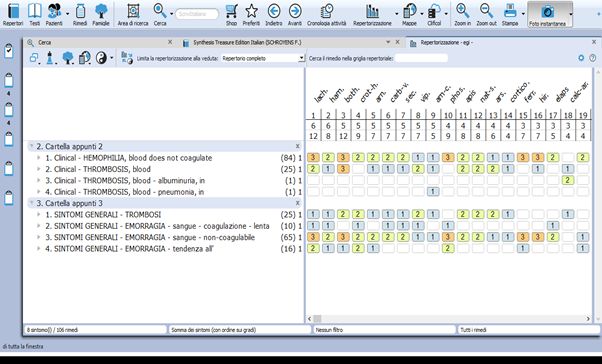
A second slightly more extensive repertorization from Synthesis alone, included the generic but unavoidable symptom of pneumonia, those related to anosmia/ageusia, a peculiar and recurrent symptom, and finally a small symptom such as pulmonary embolism with a single remedy Bothrops at the first degree, but evaluated with double intensity, given the value of the symptom.
In this case, the large polycrests, particularly Phosphorus, quickly outperform the snake venoms, which however are always close in the number of symptoms covered.
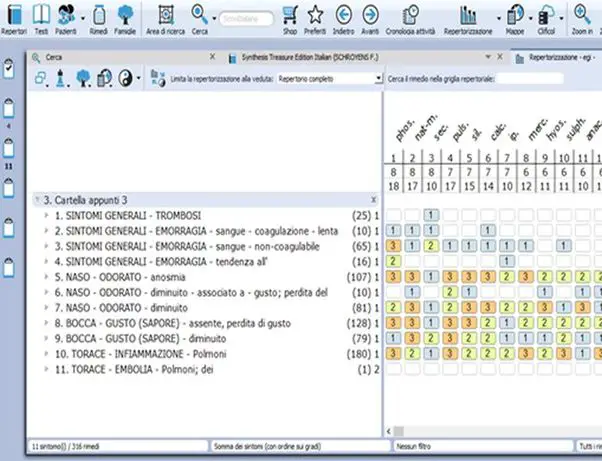
In these cases, the homeopathic repertory should be used “cum grano salis” in order not to sacrifice too many “small” remedies that have not been experimented with but that are potentially very useful.
I would not underestimate, for example, the value of organotropic and lesional similarity as a somatized microcosmic aspect of a deeper condition, but with a different language. When the pathology is expressed at a certain level, it “demands” to be treated, especially in the compromised patient, at that level.
Many homeopathy masters emphasize the importance of ‘going where there is more energy in the case’ and the symptoms are sharper and more intense. Also in Chinese Medicine, it is a priority to treat obstructions to blood/energy circulation for restoration of health.
As always in Classical Homeopathy, however, it is essential to assess the totality of the symptomatological picture of the patient and the energetic, clinical and miasmatic conditions, avoiding standardized prescriptions and customizing the therapy as best as possible, without prejudice.
The Bothrops Jararaca or Lanceolatus
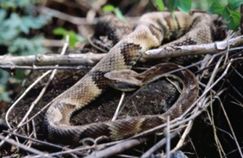
It is the most common venomous snake in southeastern Brazil, Paraguay, northern Argentina and Martinique. The name of the species, jararaca, comes in the indigenous language Tupi from yarará and ca, which mean “big serpent”, as it can exceed a 160 cm of length.
It is also called “fer de lance” due to the typical shape of the head, which evokes, like a spearhead, its special aggressiveness, rapidity and lethality (3). It is responsible for most snakebite poisonings in those areas; with treatment, the mortality rate, estimated at about 7%, is reduced to 0.5-3%.
For humans, the LD 50 is estimated to be 210 mg (3.2 g) subcutaneously. Suggestive (almost virus-like!) ethological note: being ovoviviparous, the offspring grow inside the mother’s body and a single snake can sire more than a hundred young!
The venom of the Brazilian spearhead viper contains as prevalent active ingredients (1):
– an inhibitor of the angiotensin-converting enzyme (ACE), BPP5a, (Bradykinin Potentiating Peptide); from this substance, a nonapeptide that binds to the ACE receptor, isolated in 1965 by the Brazilian pharmacologist S.H. Ferreira, was produced, the first ACE inhibitor, Captopril, with vasodilator and antihypertensive action; its pro-bradykinin action may also contribute to pulmonary angioedema.
This natural molecule can therefore be considered the precursor of new generations of drugs active on both the renin-angiotensin-aldosterone system (RAAS) and the kallicrein-kinin system: ACE inhibitors, AT1 inhibitors (sartans) and MR-antagonists (spironolactone). Recent studies (7) on this protein, also present in the venom of the similar Bothrops asper or atrox, have demonstrated an ability to reduce Alzheimer’s amyloid plaques, to bind also the ACE2 receptor and to antagonize the SARS-CoV-2!
– of metalloendopeptidases that degrade the extracellular matrix and components of the coagulation cascade leading to hemorrhage, edema, inflammation, and necrosis to consumer coagulopathy (DIC). Research by Correa et al. on melanoma cells has shown that Bothrops jararaca venom is able to suppress the growth of murine melanoma cells by inhibitors of metal proteinases called disintegrins.
– a serine endopeptidase (BjSP) that acts on platelet aggregation, fibrinolysis and the complement system, inhibiting fibrin clot formation in a manner different from other snake venoms and heparin; it has a high affinity for the TMPRS2 protein that promotes penetration of SARS-CoV-2 into alveolocytes (8).
– C-type lectin with anticoagulant, procoagulant, platelet activation agonist/antagonist action.
The venom also contains other components with cardiovascular effects (vasodilation and hypotension), which act on coagulation systems, such as Von Willebrand factor, (hemorrhagic action), on vascular permeability (edemigenous action), on the nervous system (neurotoxic action) and cause inflammation and necrosis.
Endothelial and alveolar damage caused by viral (and BPP5a, ) binding to the ACE and ACE2 receptors, which are very similar to each other, and blood stasis promoted by inflammation could complete Virchow’s triad that predisposes to thromboembolic complications.
From the Bothrops venom is obtained the batroxobine or reptilase, used in allopathic therapy for many years as a coagulant to promote hemostasis (trade name Botropase®). Batroxobin binds to fibrinogen in a way distinct from thrombin and is effective in all coagulation defects that, in the coagulation cascade, occur upstream of the transformation of fibrinogen into fibrin.
The molecule is not inactivated by heparin or equivalent anticoagulants. At very high dosages, according to the principle of reversal of action, it acts as an anticoagulant inducing a state of hypofibrinogenemia.
Information on Bothrops l. in the Materia Medica (17) and in the Homeopathic Repertory is scarce. There is a pathogenesis based almost solely on data from snakebite poisonings, thus limited mostly to organic and lesional symptoms.
Only one proving with 200 CH potency from 1935 on the related Bothrops atrox and one from 2005 by Dr. Marim (12) are known. The homeopathic Bothrops is effective both in diseases resulting from thrombophilia: vascular thrombosis (phlebitis, coronary artery disease and myocardial infarction), retinal or cerebral thrombosis (right hemiplegia with aphasia), and in those resulting from hypocoagulability: Unstoppable black blood hemorrhages (epistaxis, gingivorrhages, petechiae, ecchymoses, edemas, cerebral hemorrhages, hematemesis, rectorrhages, conjunctival and retinal hemorrhages) and Disseminated Intravascular Coagulation (DIC).
The prevailing biological basis of the action of the venom is always hypercoagulability or thrombophilia, more pronounced than in other Crotalides, so it is considered the most dangerous among them, having a greater tendency to give thromboembolic complications (11).
Characteristic symptoms
Violent pains that arise rapidly and radiate up to the root of the limb, gravitating or punctuating pain or oppression in the cardiac region as if there was no room for the heart < night, difficulty in breathing deeply until asphyxia, (the sensation of suffocation or drowning reported by severe subjects with covid-19?), constant cough sometimes with hemophthisis, palpitations and tachycardia.
Swollen and bluish-red face, obnubilated senses, amaurosis, low vision during the day and at sunset, aphasia and dysarthria, gangrene, necrosis, hemiplegia, dysphagia especially for liquids, nerve tremor, right laterality or crossed symptoms, muscle pain as from intense physical exercise, syncope, convulsions.
Psychological characteristics of the patient
Anxiety, impatience with unreasonable agitation, strong asthenia especially upon awakening with slowness and depression characterize the psyche of the Bothrops patient who forgets or misses words while speaking with aphasia. Taciturn, unwilling to speak. Astonishment, confusion, hypochondria.
Modalities and sensations
Worsens: on the right side
Sensations: numbness of the limbs, weakness of the legs as if they could not support the body, sharp pain, chest oppression to the point of asphyxia, lightheadedness, nausea.
Paul Herscu in his study (8) formulated the segments of the Bothrops cycle:
Thrombus formation, >fullness >irritation >inflammation >bleeding>weakness>paralysis which brings us back to thrombus formation.
An extremely interesting finding is that BPP5a contained in the venom inhibits ACE by preventing angiotensin II from stimulating AT1 receptors. It is recalled that in COVID-19 ACE2 is reduced (downregulation) by binding to SARS-CoV-2 virus, which by binding to these receptors penetrates into the target cells, and cannot balance ACE and its vasoconstrictive and inflammatory effects.
Genetic studies have identified the presence of enzymes homologous to ACE including angiotensin-converting enzyme 2 (ACE2), which is part of an endogenous hormonal system with an antagonistic effect on RAAS.
The action of ACE2 is through the conversion of angiotensin II to angiotensin 1-7, which, through the MAS receptor, promotes the release of vasoactive peptides such as NO, bradykinin, and PGE21 with vasodilator, anti-inflammatory, and organ-protective effects.
Similar to the ACE enzyme, ACE2 is also a transmembrane protein with an extracellular catalytic site. The enzymatic activity of ACE2 appears to be reduced with aging and to be higher in female subjects, moreover, it is subject to gene polymorphisms that modify its individual reactivity and sensitivity.
RESULTS
The above data suggest the preferential indication of Bothrops both for the remarkable biochemical similarity between the ACE enzyme and ACE2, to which it binds, as well as for that between the serine protease BjSP and the transmembrane serine protease type 2 (TMPRS2) that promotes viral uptake on the wall of alveolar type II epitheliocytes.(8)
As mentioned above, Bothrops venom and the derived drug Botropase® are not antidoted by heparin and other anticoagulants. The heparin resistance of bothrops venom is another indication of a high similarity between this remedy and the particular coagulative state induced by SARS-CoV-2.
Furthermore, it is the only remedy reported in the symptom ‘pulmonary embolism’ in the Radaropus® Homeopathic Repertory.
It is believed that Bothrops is probably the most indicated among the snake venoms used in homeopathy in the second and third phase of the disease, based on the high affinity with the anatomopathological and clinical picture of COVID-19 but also for the presence of molecular targets shared with SARS-CoV-2, a basal but significant level of similarity.
DISCUSSION
As heuristics teaches us, human reasoning makes extensive use of thinking shortcuts to reach quick conclusions with minimal cognitive effort. What makes these styles of thinking dysfunctional is not their presence, but their rigidity and inflexibility that produces cognitive biases and causes prejudices or errors of judgment.
In homeopathy one of the possible risks is a rigid consideration of methodology and an uncritical dependence on classical sources. In fact, we know how experiments, medical subjects and consequently repertories are largely incomplete and the quality and quantity of information are very unequal among different remedies.
This can lead to a fallacious evaluation in differential diagnoses and a preference for the remedies that we know better, usually polychrests, or those that the mathematics of the repertory suggests to us. The right research of the simillimum and not of a simple similar, sometimes requires the use of approaches and sources not usual in homeopathic studies, but not unreliable for this reason, which suggest a deeper congruence of the remedy.
For example, the physiopathology of Covid 19 would suggest that the true simillimum must necessarily act on the hemocoagulative alterations. If we study the scarce pathogenesis of Bothrops we see that many symptoms are not transferred in the repertories and that many of these cover important symptoms of the clinical picture that is usually referred to the various Bry., Gels., Ars., Phos., Lach. etc. more often resulting from the usual repertorization.
The homeopathic therapeutic tool bag for COVID-19 expands significantly with remedies derived from snake venoms. Obviously, an extensive clinical validation of the theoretical assumptions we have reported is necessary and the use during the still enduring pandemic may allow us to gain experience.
Also desirable would be the realization of new homeopathic experimental pathogenesis, especially of lesser known remedies, such as Bothrops lanceolatus, which seem particularly indicated in several epidemic virosis of potentially high severity; just think of Ebola virus or those from coronavirus of SARS and MERS or COVID-19, for which there is still a lack specific therapies and efficient vaccines.
The pharmacy of Nature is immense and still largely unexplored. In the recent past, homeopathy has proven its preventive and curative efficacy in several epidemics (cholera, yellow fever, Spanish flu, leptospirosis, meningitis, etc.).
The example of Bothrops venom, precursor of ACE inhibitors, shows how biochemical and pharmacological knowledge also allow us to establish a physiopathological affinity, in this case with the SARS-CoV-2 virus, being able in certain cases to suggest a homeopathicity, even if organotropic, but that can be very useful on the therapeutic level, building a bridge between different but complementary and synergistic approaches to knowledge, in the perspective of an Integrated Medicine, truly at the service of all sentient beings.
CONCLUSIONS
Both the absolute tolerability of homeopathic therapy and its action of promoting innate immunity, the primary bulwark against viruses, and also the ability to rebalance inflammatory and hemocoagulative dysfunctions, the constitutional terrain, the individual PNEI constellation, indicate as a first choice the integrated homeopathic contribution.
It can be, with its holistic vision, a fundamental plus especially in fragile, immunocompromised, elderly and poly-treated subjects with pre-existing comorbidities, in which the prognosis is more unfavorable, both quoad vitam and for the not negligible chronic sequelae, including psychological, that a disease like COVID 19 often involves in the presence of serious complications.
We thank Dr Lucia Gasparini and Dr Sebastiano Di Salvo for their scientific contribution.
Bibliografia essenziale
1) Beeton C., in Handbook of Biologically Active Peptides (Seconda Edizione) , 2013
2) Calabrese F. et al, 2020 : Patologia polmonare e COVID-19: lezioni dall’autopsia. L’esperienza dei patologi polmonari europei;
3) Cappello L.: Il misterioso mondo dei serpenti, materia medica omeopatica simbolica ed. Nuova Ipsa 2012
4) Marchetti M. 2020: COVID-19 guidato per il danno endoteliale: complemento, HIF-1, e ABL2 sono potenziali vie di danno e bersagli di cura.
5) Fraser P.: Serpenti, estrarre il potere dal mondo sotterraneo. Ed. Salus Infirmorum, 2014.
6) Gasparini L.: Studio di Materia Medica Omeopatica, Salus Infirmorum Editore, Padova, 2017 (seconda edizione).
7) Gasparini L.: Metodologia Clinica Omeopatica nel Covid-19 Parte 1-2-34, ResearchGate.net ,2020
8) Hoffmann, H. Kleine-Weber, S. Schroeder, N. Kruger, T. Herrler, S. Erichsen, TS Schiergens, G. Herrler, NH Wu, A. Nitsche, MA Muller, C. Drosten, S. Pohlmann , Cell 181 (2) (2020) 271-280 e8 10.1016 / j.cell.2020.02.052.
9) Li, W., Zhang, C., Sui, J., Kuhn, JH, Moore, MJ, Luo, S., Wong, SK, Huang, IC, Xu, K., Vasilieva, N., et al. EMBO J 24, 1634-1643.
10) Othman H, Bouslama Z, Brandenburg JT, et al. Biochem Biophys Res Commun. 2020; 527 (3): 702-708. doi: 10.1016 / j.bbrc.2020.05.028.
11) https://lens.monash.edu/@coronavirus-articles/2020/05/07/1380319/snakes-alive-venom-may-play-a-role-in-the-fight-against-covd-19
12) https://newatlas.com/snake-venom-alzheimers/42379/
13) https://nesh.com/the-new-england-journal-of-homeopathy/vol-8-no-2-fallwinter-1999/bothrops-lanceolatus-paul-herscu/
14) Hahnemann S. F.C Le malattie croniche. Cemon, 2008
15) Hahnemann S.F.C.: Organon dell’arte di guarire. Con integrazioni e commenti didattici utili per la comprensione e l’insegnamento della Medicina Omeopatica. Adattamenti di G. Fagone. Salus Infirmorum Edizioni, Padova, 2017.
16) Kamiguti A.S., Cardoso J.L., Theakston R.D., Sano-Martins S., Hutton R.A., Rugman F.P., Warrell D.A., Hay C.R. Coagulopathy and hemorrhage in human victims of Bothrops jaraca envenoming in Brazil. Toxicon 1991;29 (8):961-972.
17) Marim Matheus AMHB 3. Congresso della Federazione delle Associazioni Mediche Omeopatiche Argentine. Buenos Aires – 25 a 28 outubro di 2.000 -Radaropus
18) Mazzaccaro D., Giacomazzi F., Giannetta M., Varriale A., Scaramuzzo R., Modafferi A., Malacrida G., Righini P., Marrocco-Trischitta M.M., Nano G. Non-Overt Coagulopathy in Non-ICU Patients with Mild to Moderate COVID-19 Pneumonia. J Clin Med 2020;9(6):1781.
19) Tang N, Bai H, Chen X, Gong J, Li D, Sun Z. Il trattamento anticoagulante è associato a una minore mortalità nei pazienti con grave malattia da coronavirus 2019 con coagulopatia J Thromb Haemost 2020 May;18(5):1094-1099.
20) Tang N, Li D, Wang X, Sun Z. I parametri di coagulazione anormali sono associati a una prognosi sfavorevole nei pazienti con polmonite da nuovo coronavirus. J Thromb Haemost 2020 Apr;18(4):844-847.
21) Varga Z, Flammer AJ, Steiger P, et al. Infezione delle cellule endoteliali ed endotelite in COVID-19. Lancet 2020;395:1417-18.
22) Vermeulen F. Materia Medica Sinottica vol.1- 2 ed. Salus Infirmorum 2007
23) Walls AC et al. Structure, Function, and Antigenicity of the SARS-CoV-2 Spike Glycoprotein. Cell. Mar 6, 2020. doi:10.1016/j.cell.2020.02.058. [epub ahead of print].
24) Wiersinga W.J, Rhodes A., Cheng A.C. et al. Fisiopatologia, trasmissione, diagnosi e trattamento della malattia da Coronavirus 2019 (COVID-19): A Review | Critical Care Medicine | JAMA | JAMA Published online July 10, 2020. doi:10.1001/jama.2020.1283




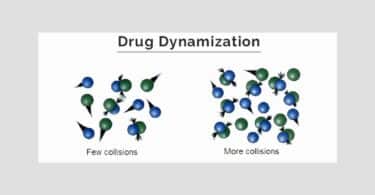

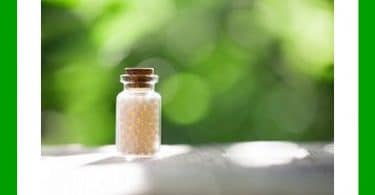
I checked for snakes that particularly cause Anosmia, and collected some information in this medium article https://meherkiran.medium.com/homeopathic-mulga-snake-remedy-for-covid-9611656376c
Enriched by details of analytical symptoms,venom therapy may be of use in serious condition.more case studies shall give the strength of use.b
Thanks to my Italian homeopathic doctor E. Galli, after 8 mnths of dreadfull tiredness and long respiratory problems; 21days of Bothrops 30ch took away conpletely my tiredness for the full 100% as well as long/respiratory problems.